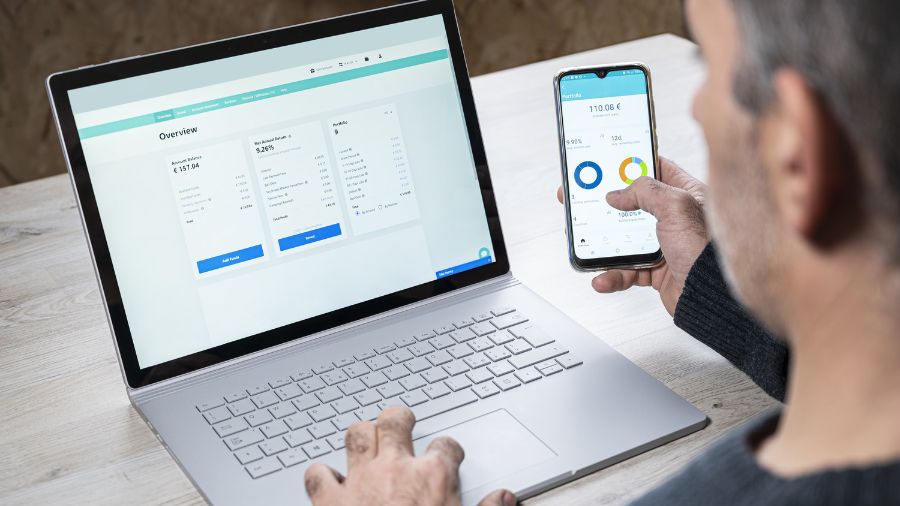It’s the least wonderful time of year of a lot of small business owners – tax season. Maybe you owe more than you thought you would. Maybe you’re encountering a cash flow issue. Maybe you still have to get all your documents together for your accountant. Either way, we’ve got you covered with some tips and tricks to help you prepare for tax season.

Get Your Business Taxes Together with the Help of QuickBooks and FundThrough
Step 1: Determine Your Return Type
While every business must file a business income tax return, not every business will file the same type of return.
If you’re self-employed, or your business is structured as a sole proprietorship or partnership, your business income must be reported on both your T1 personal tax return and a Form T2125 (Statement of Business or Professional Activities).
If your business is incorporated, any income must be reported on a T2 corporate income tax return form.
Step 2: Determine your return deadline
Once you know the type of return you’re filing, it’s important to figure out when your business tax return is due.
If you’re self-employed, or your business is structured as a sole proprietorship or partnership, your return is due June 15. Keep in mind that any tax owing from the previous year must be paid by April 30. In addition, you’ll also need to file an annual partnership information return by March 31.
If your business is incorporated, the tax filing deadline is typically six months following your fiscal year-end. However, if you’re structured as a Canadian Controlled Private Corporation (CCPC) you will need to pay any outstanding tax balance within three months after your year-end. If your business is not a CCPC, any tax owing is due within two months of your year-end.
Step 3: Choose your return method
You can prepare your business tax return in one of three ways:
File a paper return. This DIY method is nowhere near as popular as it once was, but it’s still an option if you prefer the old school hard copy way of doing things. Simply print the required forms from the Canadian Revenue Agency (CRA) website, along with the required tax slips and return by mail.
File an online return. The majority of business owners file their tax returns electronically, using CRA-certified tax preparation software, such as TurboTax. This software makes it easy, safe, and convenient for people to file online. While many tax filing software programs must be purchased, there are free options available. Whichever tax software you choose, make sure that it supports filing in your province.
Hire a professional. Hiring a professional accountant or tax preparer to complete your business tax return is a great option for those who want to skip the hassle of filing themselves, or want to ensure they’re maximizing deductions and tax planning. (We partner with experts who can help with tax preparation). While it is more expensive than the other two options, you can claim the cost of tax preparation as a business expense. Make sure your books are up to date to avoid any filing delays or additional fees.
Step 4: Organize your paperwork
Whether you’re filing your return yourself or working with a tax professional, you’ll need to get your paperwork in order. Keeping your books organized throughout the year will help streamline the process at year-end and tax filing season. QuickBooks software makes it easy to track your income and expenses, so your books are accurate and up to date, automatically.
Step 5: Maximize your available deductions
Ensuring that your business claims all the qualified business expenses it can as deductions will reduce your total taxable income.
In addition, home-based business can claim expenses such as:
- Automobile costs
- Mortgage interest
- Internet and phone costs
- Repairs
- Home cleaning service
- Security alarm monitoring fees
- Utilities (hydro, gas, water)
If you drive to work for your business, you may be eligible to claim:
- Gas, insurance, and any repairs for your vehicle (you’ll need to keep a mileage log)
Your business may also be eligible for additional deductions through:
- Capital cost allowance. The capital cost allowance accounts for the depreciation of business-related assets and equipment like computers, machinery, furniture, property, etc. You can also claim CCA on items such as vehicles or even musical instruments that you use to earn an income.
- Your Registered Retirement Savings Plan. If your business operates as a sole proprietorship or partnership, maximizing your RRSP contributions will help to reduce your total taxable income.
- Charitable donations and gifts for employees. Donations made on behalf of your company to a registered charity can be claimed as a deduction. In addition, gifts the company gives to employees during the year can also be claimed.
There are a great many deductions available to help reduce the amount of tax your business owes. Take the time to explore all options to ensure you’re maximizing your return. To make sure you aren’t missing out on eligible opportunities, consult a tax professional or use an online tax preparation software.
Step 6: Take advantage of tax credits
By taking advantage of eligible tax credits, you can lower the amount of taxes you owe come deadline time.
There are a wide range of provincial and federal tax incentives available to Canadian businesses of all sizes and in various sectors. Spending a bit of time checking to see if your organization is eligible for any of these credits could end up saving you big bucks.
Some tax credits for small businesses include:
- The Scientific Research & Experimental Development (SR&ED) tax credit program
- The Manufacturing and processing profits deduction
- The Federal foreign business income tax credit
- Investment tax credits
- The Apprenticeship Job Creation tax credit
Step 7: Boost your cash flow
If you’ve followed these steps and wound up owing more than you thought you would, you could find yourself in a real cash flow crunch. If you aren’t sure how you’ll pay your tax balance, or just need cash to cover off everyday expenses in the meantime, invoice funding offers a solution.
With invoice funding, a business owner sells invoices to a factoring company. The business owner receives cash for the invoice amount, usually less fees, ahead of the payment terms. The business owner’s customer, who is responsible for paying the invoice, instead pays the invoice amount to the factoring company according to the original payment terms. It provides complete confidence knowing that your cash is secured by an expected invoice payment.
Cash flow issues are a major challenge for small business owners, often due to long payment terms their customers expect. If you want to speed up cash flow with quick access to funding, a factoring company like our trusted partner FundThrough can help. As an added bonus, it’s fully integrated with QuickBooks Online. Here are a few common reasons small businesses use invoice funding:
- Making payroll costs, hiring new employees
- Buying new equipment
- Paying their own suppliers & operating expenses
- Fulfilling large orders or projects that drive growth
- Funding at strategic times to bolster books
If you aren’t prepared, tax season can be a busy, stressful time of year as a small business. But, with a bit of planning and by staying on top of your bookkeeping throughout the year, you can be ready to file and make payments on time without the headache.
About FundThrough
FundThrough is a leading fintech company accelerating cash flow and enabling growth for small and medium businesses. Based in Toronto, FundThrough’s AI-powered invoice funding platform gives B2B businesses fast, customized funding offers to get their invoices paid in a few days - rather than a few months - and get quick access to cash that’s already theirs. For more information, go to http://www.fundthrough.com. To learn about FundThrough’s partnership with Intuit QuickBooks and how you can fund an invoice, click here. If you’re ready to create a free, QuickBooks integrated account, get started here.


